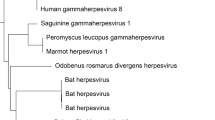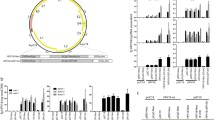Abstract
Walleye dermal sarcoma virus (WDSV) is etiologically associated with a skin tumor, walleye dermal sarcoma (WDS), which develops in the fall and regresses in the spring. WDSV genome contains, in addition to gag, pol and env, three open reading frames (orfs) designated orf a (rv-cyclin), orf b and orf c. Unintegrated linear WDSV provirus DNA isolated from infected tumor cells was used to construct a full-length WDSV provirus clone pWDSV, while orf a was cloned into pSVK3 to construct the expression vector porfA. Stable co-transfection of a walleye cell line (W12) with pWDSV and pcDNA3 generated fewer and smaller G418-resistant colonies compared to the control. By Northern blot analysis, several small transcripts (2.8, 1.8, 1.2, and 0.8 kb) were detected using a WDSV LTR-specific probe. By RT-PCR and Southern blot analysis, three cDNAs (2.4, 1.6 and 0.8 kb) were identified, including both orf a and orf b messenger. Furthermore stable co-transfection of both a human lung adenocarcinoma cell line (SPC-A-1) and a cervical cancer cell line (HeLa) with pcDNA3 and ether porfA or pWDSV also generated fewer and smaller G418-resistant colonies. We conclude that expression of the full-length WDSV clone or the orf a gene inhibits the host fish and human tumor cell growth, and Orf A protein maybe a potential factor which contributes to the seasonal tumor development and regression. This is the first fish provirus clone that has been expressed in cell culture system, which will provide a new in vitro model for tumor research and oncotherapy study.










Similar content being viewed by others
References
Bowser PR, Wolfe MJ, Forney JL, Wooster GA (1988) Seasonal prevalence of skin tumors from walleye (Stizostedion vitreum) from Oneida Lake, New York. J Wildl Dis 24(2):292–298
Martineau D, Bowser PR, Renshaw RR, Casey JW (1992) Molecular characterization of a unique retrovirus associated with a fish tumor. J Virol 66(1):596–599
Bowser PR, Wooster GA, Getchell RG, Chen CY, Sutton CA, Casey JW (2002) Naturally occurring invasive walleye dermal sarcoma and attempted experimental transmission of the tumor. J Aquatic Animal Health 14(4):288–293
Martineau D, Renshaw R, Williams JR, Casey JW, Bowser PR (1991) A large unintegrated retrovirus DNA species present in a dermal tumor of walleye Stizostedion vitreum. Dis Aquat Org 10:153–158
Holzschu DL, Martineau D, Fodor SK, Vogt VM, Bowser PR, Casey JW (1995) Nucleotide sequence and protein analysis of a complex piscine retrovirus, walleye dermal sarcoma virus. J Virol 69(9):5320–5331
LaPierre LA, Casey JW, Holzschu DL (1998) Walleye retroviruses associated with skin tumors and hyperplasias encode cyclin D homologs. J Virol 72(11):8765–8771
Bowser PR, Wooster GA, Quackenbush SL, Casey RN, Casey JW (1996) Comparison of fall and spring tumors as inocula for experimental transmission of walleye dermal sarcoma. J Aquatic Animal Health 8(1):78–81
Daniels CC, Rovnak J, Quackenbush SL (2008) Walleye dermal sarcoma virus Orf B functions through receptor for activated C kinase (RACK1) and protein kinase C. Virology 375(2):550–560. doi:10.1016/j.virol.2008.01.034
Rovnak J, Casey RN, Brewster CD, Casey JW, Quackenbush SL (2007) Establishment of productively infected walleye dermal sarcoma explant cells. J Gen Virol 88(Pt 9):2583–2589. doi:10.1099/vir.0.82967-0
Rovnak J, Quackenbush SL (2010) Walleye dermal sarcoma virus: molecular biology and oncogenesis. Viruses 2(9):1984–1999. doi:10.3390/v2091984
Boya P, Pauleau AL, Poncet D, Gonzalez-Polo RA, Zamzami N, Kroemer G (2004) Viral proteins targeting mitochondria: controlling cell death. Biochim Biophys Acta 1659(2–3):178–189. doi:10.1016/j.bbabio.2004.08.007
Nudson WA, Rovnak J, Buechner M, Quackenbush SL (2003) Walleye dermal sarcoma virus Orf C is targeted to the mitochondria. J Gen Virol 84(Pt 2):375–381
Rovnak JHB, Ryan SO, Cai S, Quackenbush SL (2005) An activation domain within the walleye dermal sarcoma virus retroviral cyclin protein is essential for inhibition of the viral promoter. Virology 342(2):240–251
Rovnak J, Quackenbush SL (2006) Walleye dermal sarcoma virus retroviral cyclin directly contacts TAF9. J Virol 80(24):12041–12048. doi:10.1128/JVI.01425-06
Rovnak J, Casey JW, Quackenbush SL (2001) Intracellular targeting of walleye dermal sarcoma virus Orf A (rv-cyclin). Virology 280(1):31–40. doi:10.1006/viro.2000.0731
Rovnak J, Quackenbush SL (2002) Walleye dermal sarcoma virus cyclin interacts with components of the mediator complex and the RNA polymerase II holoenzyme. J Virol 76(16):8031–8039
Quackenbush SL, Linton A, Brewster CD, Rovnak J (2009) Walleye dermal sarcoma virus rv-cyclin inhibits NF-kappaB-dependent transcription. Virology 386(1):55–60. doi:10.1016/j.virol.2008.12.026
Brewster CD, Birkenheuer CH, Vogt MB, Quackenbush SL, Rovnak J (2011) The retroviral cyclin of walleye dermal sarcoma virus binds cyclin-dependent kinases 3 and 8. Virology 409(2):299–307. doi:10.1016/j.virol.2010.10.022
Lairmore MD, Stanley JR, Weber SA, Holzschu DL (2000) Squamous epithelial proliferation induced by walleye dermal sarcoma retrovirus cyclin in transgenic mice. Proc Natl Acad Sci USA 97(11):6114–6119. doi:10.1073/pnas.110024497
Paul TA, Rovnak J, Quackenbush SL, Whitlock K, Zhan H, Gong Z, Spitsbergen J, Bowser PR, Casey JW (2011) Transgenic expression of walleye dermal sarcoma virus rv-cyclin (orfA) in zebrafish does not result in tissue proliferation. Mar Biotechnol (NY) 13(2):142–150. doi:10.1007/s10126-010-9274-2
Zhan H, Spitsbergen JM, Qing W, Wu YL, Paul TA, Casey JW, Her GM, Gong Z (2010) Transgenic expression of walleye dermal sarcoma virus rv-cyclin gene in zebrafish and its suppressive effect on liver tumor development after carcinogen treatment. Mar Biotechnol (NY) 12(6):640–649. doi:10.1007/s10126-009-9251-9
Zhang Z, Martineau D (1999) Walleye dermal sarcoma virus: OrfA N-terminal end inhibits the activity of a reporter gene directed by eukaryotic promoters and has a negative effect on the growth of fish and mammalian cells. J Virol 73(10):8884–8889
Quackenbush SL, Holzschu DL, Bowser PR, Casey JW (1997) Transcriptional analysis of walleye dermal sarcoma virus (WDSV). Virology 237(1):107–112. doi:10.1006/viro.1997.8755
Clements JE, Zink MC, Narayan O, Gabuzda DH (1994) Lentivirus infection of macrophages. Immunol Ser 60:589–600
Chebloune Y, Karr B, Sheffer D, Leung K, Narayan O (1996) Variations in lentiviral gene expression in monocyte-derived macrophages from naturally infected sheep. J Gen Virol 77(Pt 9):2037–2051
Clements JE, Zink MC (1996) Molecular biology and pathogenesis of animal lentivirus infections. Clin Microbiol Rev 9(1):100–117
Berasain C, Patil D, Perara E, Huang SM, Mouly H, Brechot C (1998) Oncogenic activation of a human cyclin A2 targeted to the endoplasmic reticulum upon hepatitis B virus genome insertion. Oncogene 16(10):1277–1288. doi:10.1038/sj.onc.1201893
Brechot C (1993) Oncogenic activation of cyclin A. Curr Opin Genet Dev 3(1):11–18
Hoang AT, Cohen KJ, Barrett JF, Bergstrom DA, Dang CV (1994) Participation of cyclin A in Myc-induced apoptosis. Proc Natl Acad Sci USA 91(15):6875–6879
Meikrantz W, Gisselbrecht S, Tam SW, Schlegel R (1994) Activation of cyclin A-dependent protein kinases during apoptosis. Proc Natl Acad Sci USA 91(9):3754–3758
Hijmans EM, Voorhoeve PM, Beijersbergen RL, van ‘t Veer LJ, Bernards R (1995) E2F-5, a new E2F family member that interacts with p130 in vivo. Mol Cell Biol 15(6):3082–3089
Sardet C, Vidal M, Cobrinik D, Geng Y, Onufryk C, Chen A, Weinberg RA (1995) E2F-4 and E2F-5, two members of the E2F family, are expressed in the early phases of the cell cycle. Proc Natl Acad Sci USA 92(6):2403–2407
Vaishnav YN, Vaishnav MY, Pant V (1998) The molecular and functional characterization of E2F-5 transcription factor. Biochem Biophys Res Commun 242(3):586–592. doi:10.1006/bbrc.1997.8010
Jiang Y, Yim SH, Xu HD, Jung SH, Yang SY, Hu HJ, Jung CK, Chung YJ (2011) A potential oncogenic role of the commonly observed E2F5 overexpression in hepatocellular carcinoma. World J Gastroenterol: WJG 17(4):470–477. doi:10.3748/wjg.v17.i4.470
Kothandaraman N, Bajic VB, Brendan PN, Huak CY, Keow PB, Razvi K, Salto-Tellez M, Choolani M (2010) E2F5 status significantly improves malignancy diagnosis of epithelial ovarian cancer. BMC Cancer 10:64. doi:10.1186/1471-2407-10-64
Amatruda JF, Shepard JL, Stern HM, Zon LI (2002) Zebrafish as a cancer model system. Cancer Cell 1(3):229–231
Patton EE, Zon LI (2001) The art and design of genetic screens: zebrafish. Nat Rev Genet 2(12):956–966. doi:10.1038/35103567
Acknowledgments
Our research was supported by grants from the National Natural Science Foundation of China (No. 30870119).
Author information
Authors and Affiliations
Corresponding author
Additional information
K. Xu and T.T. Zhang are co-first authors.
Rights and permissions
About this article
Cite this article
Xu, K., Zhang, T.T., Wang, L. et al. Walleye dermal sarcoma virus: expression of a full-length clone or the rv-cyclin (orf a) gene is cytopathic to the host and human tumor cells. Mol Biol Rep 40, 1451–1461 (2013). https://doi.org/10.1007/s11033-012-2188-5
Received:
Accepted:
Published:
Issue Date:
DOI: https://doi.org/10.1007/s11033-012-2188-5




